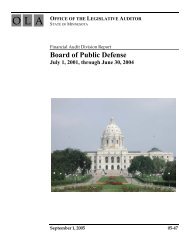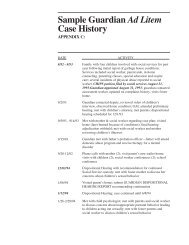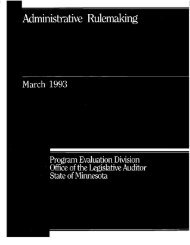Occupational Regulation - Office of the Legislative Auditor
Occupational Regulation - Office of the Legislative Auditor
Occupational Regulation - Office of the Legislative Auditor
Create successful ePaper yourself
Turn your PDF publications into a flip-book with our unique Google optimized e-Paper software.
ORGANIZATION OF OCCUPATIONAL REGULATION 45<br />
We studied<br />
several<br />
proposals for<br />
new regulation<br />
or changes in<br />
occupational<br />
regulation in<br />
order to<br />
understand <strong>the</strong><br />
process by<br />
which such<br />
proposals are<br />
considered in<br />
<strong>the</strong> Legislature.<br />
before <strong>the</strong> legislature in recent years. In order to identify <strong>the</strong> issues we searched<br />
topical indexes <strong>of</strong> bills in <strong>the</strong> House and Senate as well as <strong>the</strong> Revisor’s system. 17<br />
This process, while not a fool-pro<strong>of</strong> method <strong>of</strong> identifying all important issues,<br />
yielded a list <strong>of</strong> 38 bills (not counting companion bills) relating to 44 proposals<br />
for new regulation or changes to existing regulation. All in all, we think <strong>the</strong> list is<br />
reasonably representative <strong>of</strong> <strong>the</strong> regulatory proposals that have been introduced as<br />
bills in recent years. This list is presented in Figure 2.3. These bills propose<br />
regulatory changes affecting various occupations. Some seek new regulation, for<br />
example, licensing <strong>of</strong> naturopathic physicians. Some propose a change in <strong>the</strong><br />
level <strong>of</strong> regulation, for example, licensure instead <strong>of</strong> registration <strong>of</strong> dental<br />
assistants and physical <strong>the</strong>rapists. Some propose to increase entry requirements,<br />
for example requiring a fifth year <strong>of</strong> higher education in order to become a<br />
certified public accountant. Some proposals sought to extend <strong>the</strong> scope <strong>of</strong><br />
practice, for example to allow physician assistants <strong>the</strong> right to render emergency<br />
care without a supervising physician. Some proposals changed continuing<br />
education requirements. Only one proposal proposed a fundamental reduction in<br />
state occupational regulation: <strong>the</strong>re was a proposal to abolish <strong>the</strong> Board <strong>of</strong><br />
Architecture, Engineering, Land Surveying, Landscape Architecture, Geoscience,<br />
and Interior Design. Some proposals to change occupational regulation in<br />
Minnesota are a reflection <strong>of</strong> changes in federal requirements, o<strong>the</strong>r states’<br />
requirements, and <strong>the</strong> pattern <strong>of</strong> local government regulation.<br />
We selected 13 <strong>of</strong> <strong>the</strong> issues for more detailed study. These are listed in Figure<br />
2.4. We selected a set <strong>of</strong> proposals that was deliberately varied, including some<br />
bills that received a hearing and some that did not; some <strong>of</strong> <strong>the</strong> proposals were<br />
enacted into law, o<strong>the</strong>rs had been around for a few years without success. We<br />
chose a mix <strong>of</strong> occupations including clinical health occupations, public health<br />
occupations, and non-health pr<strong>of</strong>essions and occupations. We listened to any<br />
available tapes <strong>of</strong> <strong>the</strong> legislative committee deliberations on <strong>the</strong> bills. We talked<br />
to some <strong>of</strong> <strong>the</strong> legislators involved, and relevant agency and licensing board staff,<br />
pr<strong>of</strong>essional association representatives, lobbyists, and o<strong>the</strong>rs.<br />
A brief description <strong>of</strong> each <strong>of</strong> <strong>the</strong> case studies is provided in Appendix B. These<br />
case studies provided some <strong>of</strong> <strong>the</strong> information we use in <strong>the</strong> next chapter to reach<br />
conclusions about <strong>the</strong> effectiveness <strong>of</strong> our system <strong>of</strong> occupational regulation<br />
including <strong>the</strong> effectiveness <strong>of</strong> <strong>the</strong> process by which agencies and <strong>the</strong> legislature<br />
decide whe<strong>the</strong>r regulation is needed.<br />
17 Specifically, we reviewed <strong>the</strong> House <strong>of</strong> Representatives Topical Index <strong>of</strong> bills for 1997 and<br />
looked under topics that related to regulation. We noted which bills looked like occupational<br />
regulation proposals from <strong>the</strong> short description provided not including minor housekeeping bills.<br />
We <strong>the</strong>n cross referenced <strong>the</strong> list with <strong>the</strong> Senate Topical Index <strong>of</strong> bills for 1997. Next, we<br />
searched <strong>the</strong> Revisor’s system and used <strong>the</strong> 1997 topic headings to search for 1998 bills. Finally,<br />
we edited out bills not having to do with <strong>the</strong> subject and added bills identified from o<strong>the</strong>r sources.








